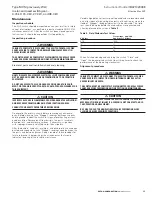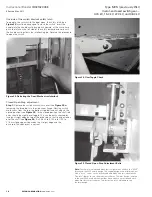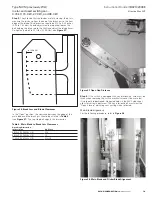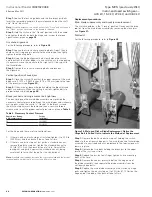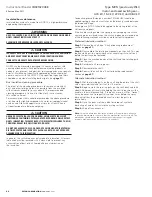
7
Instructional Booklet
IB02102006E
Effective May 2011
Type MVS (previously WLI)
metal-enclosed switchgear—
4.76 kV, 15.0 kV, 27.0 kV, and 38.0 kV
eaton corporation
www.eaton.com
Connections to a medium voltage assembly (MVA)
metal-clad switchgear assembly
Indoor switchgear
Follow the same procedures outlined in “Connections to an
AMPGARD medium voltage MCC” section above .
Outdoor switchgear
Step 1e:
Position the units side by side . The holes in the MVS side
sheet around the bus cutout will match the holes in the metal-clad
switchgear flange .
Step 2e:
Press the sponge neoprene gasketing tape, supplied with
the MVS switchgear, onto the flange for the weather-tight seal .
Step 3e:
Join the enclosures using the bolts supplied with the MVS .
The opposite side of the metal-clad switchgear flange has nuts
welded in place for ease of connection .
Step 4e:
Make the bus connections as per “Connection by busbar”
section above .
Connection of customer power cables
Figure 6
through
Figure 15
show the suggested means for connec-
tion of the incoming or exiting cables (maximum of two per phase,
500 kcmil) to the MVS switchgear . The letters in each figure apply
to the itemized subjects (A through E) that follow . All necessary
materials to perform the cable installation are to be provided by
others unless specifically noted otherwise in the detailed instruc-
tions or where specifically purchased with the switchgear assembly .
To install the incoming and exiting cables, follow these instructions .
A.
The switchgear terminals—For incoming power, the terminals
are usually located at the top of the switch in a vertical section .
For outgoing circuits, the terminals are beneath the switch if
unfused, or on the fuse mounting if fused . Each terminal pad
has a two-hole pattern suitable for either a single hole terminal
or a terminal with a two-hole National Electrical Manufacturers
Association (NEMA
T
) drilling pattern . The terminal lugs for the
cable, if purchased with the switchgear, will be bolted to the
switchgear terminals . If the terminal lugs are not there, then
they are to be provided by others . The terminals of the switch-
gear are not suitable to support the weight of the cable . It will
be necessary to support the weight of the cable with the cable
support angle discussed in C below .
B.
Cable electrical stress relief devices—The design of MVS
switchgear is based upon use of “pre-formed” type electrical
stress relief devices such as 3-M Quickterm-II
T
, Raychem
T
heat
shrink termination systems, etc . The stress relief devices are to
be provided by others .
C.
Cable support channel(s)—The cable support channel(s) is not
supplied by Eaton unless purchased as a feature at the time of
offer . The cable supports may be mounted to suit the geometry
of the installation by drilling holes in the switchgear structure
to suit . The tamper-resistant hardware provided is to anchor the
support channel(s) to the structure . Use the regular hardware to
fasten the channel(s) to the mounting clips . The means to fasten
the cable to this channel(s) is to be provided by others . There are
a large number of commercially available cable support devices
that can be fastened to this channel(s) to support the cable so
that the cable weight is not hanging on the switchgear terminals .
WARNING
FAILURE TO INSTALL THE CABLE SUPPORT MAy RESULT IN DAMAGE TO
THE SWITCHGEAR TERMINALS, WHICH IN TURN MAy RESULT IN MAJOR
EQUIPMENT DAMAGE AND CAUSE SEVERE PERSONAL INJURy OR DEATH.
THE CABLE SUPPORT MUST BE INSTALLED AS INSTRUCTED IN THIS
DOCUMENT.
D.
Lacing cord or other equivalent materials/means—The cables
must be lashed together to restrain the cables if a short circuit
should occur . This material is to be provided by others . For large
cables and/or cable reverse loops, it may also be necessary to
lash the cable bundle(s) to the support channel . The views show
this suggested fastening of the cable bundles .
WARNING
FAILURE TO LASH THE CABLES TOGETHER MAy RESULT IN DAMAGE TO
THE SWITCHGEAR, WHICH IN TURN MAy RESULT IN MAJOR EQUIPMENT
DAMAGE AND CAUSE SEVERE PERSONAL INJURy OR DEATH.
THE CABLE MUST BE LASHED TOGETHER AS INSTRUCTED IN THIS
DOCUMENT
E.
Current transformer(s)—The current transformer(s) is to be
mounted on the side of the cable support that will physically
support the current transformer(s) so it will not slide down onto
the stress relief devices . The high voltage cable is to be routed
through the current transformer . The H1 side of each current
transformer is to be toward the normal source of electric power .
Each current transformer secondary wiring is terminated at a
plug . This plug is to be placed in the terminal block receptacle to
match the phase on which the current transformer is mounted .
The switchgear terminals will have phase labeling . The secondary
wires are to be fastened to the support channel so they can not
fall into high voltage parts .

















